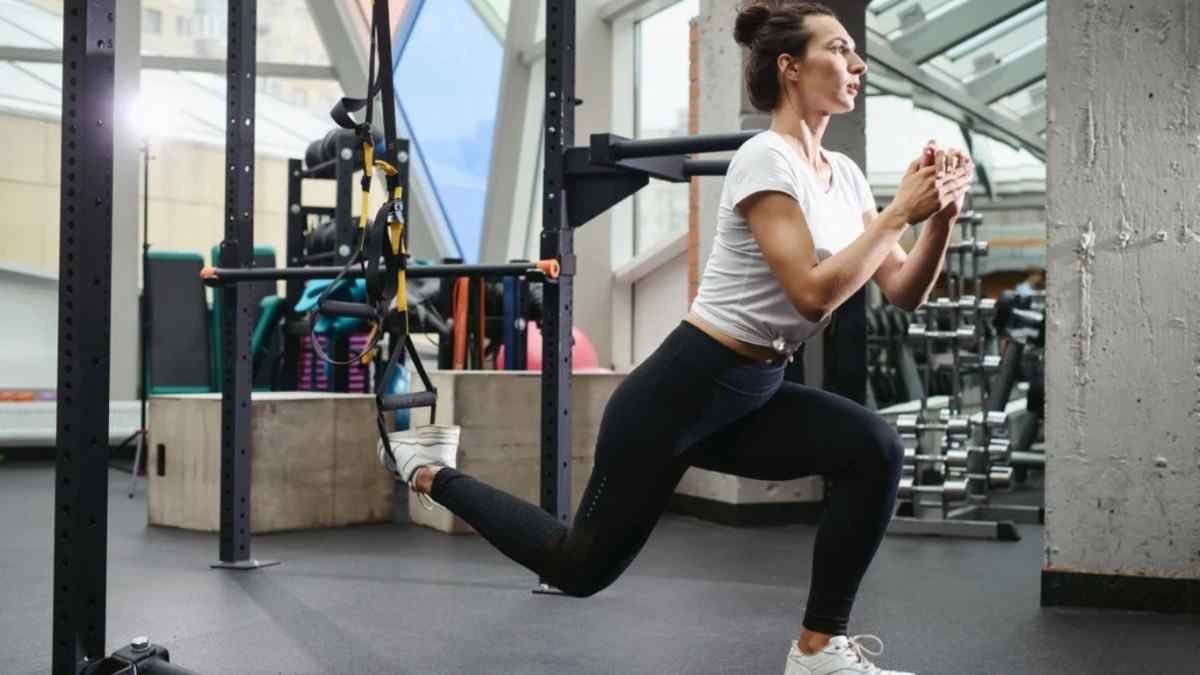Introduction
At-home strength training has gained immense popularity, especially for those looking to build muscle without a gym membership. But does it really work for muscle growth? The answer is yes—with the right approach, at-home strength training can be just as effective as traditional gym workouts. By using bodyweight exercises, resistance bands, dumbbells, or even household items, you can stimulate muscle hypertrophy and achieve significant gains.
The key to success with at-home strength training lies in progressive overload—gradually increasing resistance or intensity to challenge your muscles. Exercises like push-ups, squats, lunges, and pull-ups can be modified to increase difficulty, ensuring continuous muscle adaptation. Additionally, incorporating equipment like adjustable dumbbells or kettlebells can further enhance strength and muscle development.
Another advantage of at-home strength training is convenience and consistency. Without the need to commute, you’re more likely to stick to a routine, which is crucial for long-term muscle growth. However, proper form, nutrition, and recovery remain essential factors, just like in any workout regimen.
Ultimately, at-home strength training can deliver impressive results if programmed correctly. Whether you’re a beginner or an experienced lifter, a well-structured home workout plan can help you build strength, increase muscle mass, and achieve your fitness goals.
Benefits of At-Home Full-Body Strength Training:
At-home full-body strength training offers a wealth of benefits that cater to various fitness goals and lifestyle needs. Engaging all major muscle groups in a single session, these workouts are not only efficient but also highly effective. Here’s a breakdown of the key advantages:

1. Comprehensive Muscle Development and Strength Gains:
- Balanced Physique: Full-body workouts ensure all major muscle groups (legs, back, chest, shoulders, arms, and core) are targeted regularly, promoting balanced muscle growth and reducing the risk of muscular imbalances.
- Increased Overall Strength: By working multiple muscles simultaneously through compound exercises (like squats, deadlifts, push-ups, and rows), you build functional strength that translates to easier daily activities and improved athletic performance.
- Muscle Preservation: As we age, muscle mass naturally declines. Strength training is crucial for preserving and even increasing lean muscle.
2. Effective Fat Loss and Metabolism Boost:
- Increased Calorie Burn: Engaging multiple large muscle groups in a single session burns a significant number of calories during the workout.
- Elevated Post-Workout Metabolism (EPOC): Strength training can increase your metabolic rate for hours after your workout as your body repairs and builds muscle tissue, leading to more calories burned even at rest.
- Improved Body Composition: Building muscle and losing fat simultaneously leads to a leaner, more toned appearance. Muscle is denser than fat, so you might see changes in your physique even if the scale doesn’t move drastically.
3. Enhanced Mobility, Flexibility, and Joint Health:
- Improved Range of Motion: Performing exercises through their full range of motion can help maintain and even improve joint flexibility and mobility.
- Stronger Joints and Connective Tissues: Strength training strengthens not only muscles but also tendons and ligaments, providing better support for your joints and reducing the risk of injury.
- Better Posture and Balance: Strengthening core and back muscles contributes to improved posture, while exercises that challenge stability can enhance balance, reducing the risk of falls, especially as you get older.
4. Unmatched Convenience and Accessibility:
- Time-Efficient: Full-body workouts can be completed in a relatively short amount of time (e.g., 2-3 sessions per week) while still delivering significant results, making them ideal for busy schedules.
- Cost-Effective: You can achieve an effective full-body workout at home with minimal or no equipment (using bodyweight exercises), saving money on gym memberships and expensive gear.
- Workout Anytime, Anywhere: Enjoy the freedom to exercise on your own schedule, in the comfort and privacy of your home, without worrying about gym hours or travel time.
- Flexibility in Programming: If you miss a session, it’s generally easier to adjust your schedule with full-body workouts compared to split routines that focus on specific muscle groups on certain days.
5. Improved Overall Health and Well-being:
- Increased Bone Density: Weight-bearing exercises involved in strength training stimulate bone growth and can help prevent osteoporosis.
- Better Cardiovascular Health: While often associated with cardio, strength training also benefits heart health by improving blood pressure, cholesterol levels, and blood sugar control.
- Enhanced Mood and Reduced Stress: Physical activity, including strength training, releases endorphins, which can improve mood, reduce stress and anxiety, and promote better sleep.
- Increased Energy Levels: Regular exercise can combat fatigue and boost overall energy levels.
By incorporating at-home full-body strength training into your routine, you’re investing in a stronger, healthier, and more resilient version of yourself, all from the convenience of your own space.
Essential Equipment for Home Strength Training
Okay, let’s break down the essential equipment for your home strength training setup, keeping in mind that you can achieve a fantastic workout with very little.
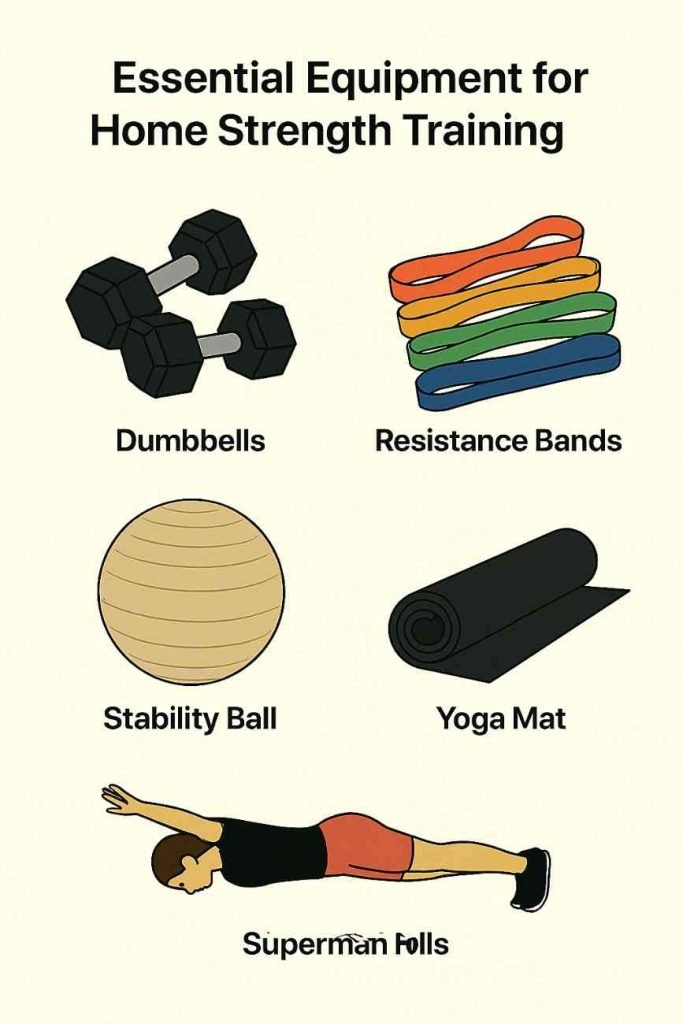
Here’s a look at your options, from a minimalist approach to some valuable additions:
1. The Minimalist Approach: Your Body is Your Gym (Bodyweight-Only Exercises)
This is the ultimate starting point and can be incredibly effective for building strength, muscle, and endurance. The beauty of bodyweight training is that it requires absolutely no equipment and can be done anywhere.
- Why it’s effective: You use your own body weight as resistance. By modifying exercises (e.g., incline push-ups vs. regular push-ups, or single-leg squats), you can continuously challenge yourself as you get stronger.
- Key Bodyweight Exercises:
- Lower Body: Squats, Lunges (forward, reverse, side), Glute Bridges, Calf Raises, Wall Sits.
- Upper Body: Push-ups (various inclines/declines), Plank variations (high, low, side), Triceps Dips (using a chair or sturdy surface), Pike Push-ups.
- Core: Crunches, Leg Raises, Bird-Dog, Mountain Climbers, Russian Twists (can be done without weight).
- Full Body/Cardio Bursts: Burpees, Jumping Jacks, High Knees.
2. Optional Additions: Level Up Your Home Workouts
As you progress or if you want more variety and targeted resistance, these pieces of equipment can be excellent investments:
- Resistance Bands (Loop and Tube with Handles):
- Benefits: Highly versatile, portable, and relatively inexpensive. They provide variable resistance, meaning the tension increases as you stretch them. Excellent for targeting smaller muscle groups, adding resistance to bodyweight exercises (e.g., banded squats), and for rehabilitation or warm-up exercises.
- Uses: Bicep curls, triceps extensions, shoulder presses, lateral walks, glute kickbacks, rows, chest presses.
- Dumbbells/Kettlebells:
- Dumbbells:
- Benefits: Allow for a wide range of exercises, isolate specific muscles, and help identify and correct strength imbalances between limbs. Adjustable dumbbells are a great space-saving and cost-effective option in the long run.
- Uses: Bicep curls, triceps extensions, shoulder presses, chest presses, rows, squats, lunges, Romanian deadlifts.
- Kettlebells:
- Benefits: Their unique shape with an offset center of gravity makes them ideal for dynamic, explosive movements and for engaging stabilizing muscles. Great for combining strength, cardio, and flexibility.
- Uses: Kettlebell swings, goblet squats, lunges, rows, Turkish get-ups, cleans, snatches.
- Dumbbells:
- Pull-Up Bar (Doorway or Wall-Mounted):
- Benefits: One of the best tools for developing upper body pulling strength, particularly for the back (lats) and biceps. Many models also allow for chin-ups (palms facing you) and neutral grip pull-ups. Some also have grips for hanging leg raises.
- Uses: Pull-ups, chin-ups, hanging leg raises, Australian pull-ups (if you have a lower bar or use rings).
- Stability Ball (Swiss Ball or Exercise Ball):
- Benefits: Adds an element of instability to exercises, forcing your core and stabilizing muscles to work harder. Great for improving balance, coordination, and core strength.
- Uses: Ball crunches, hamstring curls, glute bridges, pike push-ups with feet on ball, plank variations, back extensions. It can also be used as a bench for exercises like dumbbell chest presses.
3. DIY Alternatives: Get Creative with Household Items
If you’re on a tight budget or just starting out, everyday items can serve as temporary or even long-term resistance tools:
- Water Bottles or Milk Jugs as Weights:
- How: Fill them with water or sand (sand will make them heavier). Ensure the caps are securely fastened.
- Uses: Can be used like light dumbbells for exercises like bicep curls, lateral raises, triceps extensions, or front raises. Hold one in each hand.
- Backpack for Added Resistance:
- How: Fill a sturdy backpack with books, water bottles, or other heavy, stable items.
- Uses: Wear it during squats, lunges, push-ups (if you’re advanced), or calf raises to increase the challenge.
- Towels or Sliders (on a smooth floor):
- How: Use small towels or dedicated fitness sliders on a hardwood or tile floor.
- Uses: For exercises like hamstring curls (lying on your back, pull heels towards glutes), bodyweight rows (if you have a sturdy table to grip and slide under), or ab rollouts (from knees).
- Sturdy Chair or Bench:
- How: Use a stable chair, bench, or even sturdy steps.
- Uses: For triceps dips, incline/decline push-ups, Bulgarian split squats (rear foot elevated), step-ups.
Key Considerations When Choosing Equipment:
- Your Goals: What do you want to achieve? (e.g., muscle gain, general fitness, specific skill like pull-ups).
- Your Budget: Start small and add items as you progress and commit.
- Your Space: How much room do you have for storage and use?
- Safety: Always ensure any DIY equipment is secure and any purchased equipment is used correctly to prevent injury.
Remember, the most important “equipment” is your dedication and consistency! You can build a strong, healthy body with very little. Start with what you have, and gradually build your home gym if and when you feel the need.
Full-Body Strength Training Exercises (With Variations)
Full-body strength exercises are fantastic for building overall muscle, improving endurance, and enhancing functional fitness. Here are some effective exercises you can incorporate into your routine:
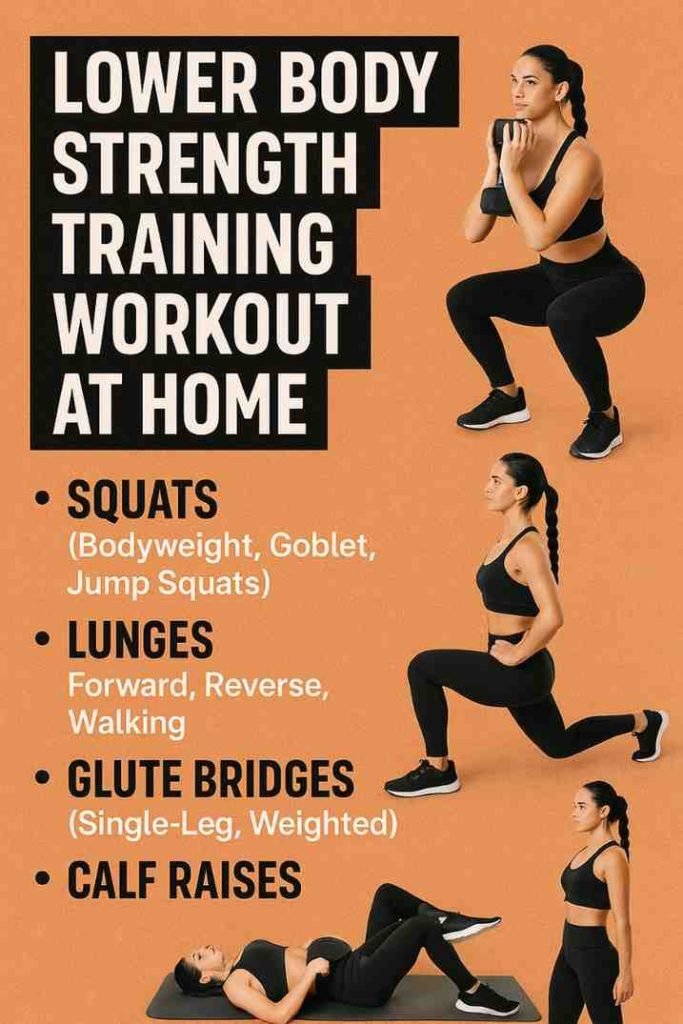
Lower Body Strength Training Workout at Home
Building strong legs and glutes is key to a balanced strength training workout. These lower-body exercises require minimal (or no) equipment and can be modified for any fitness level.
1. Squats (Targets: Quads, Glutes, Hamstrings, Core)
- Bodyweight Squat: Ideal for beginners—focus on depth and form.
- Goblet Squat (Dumbbell/Kettlebell): Adds resistance, improves posture.
- Jump Squat: Boosts power and cardio endurance.
Form Tip: Keep knees aligned with toes, chest up, and squat until thighs are parallel (or lower).
2. Lunges (Targets: Quads, Glutes, Hamstrings, Balance)
- Forward Lunge: Classic strength builder.
- Reverse Lunge: Easier on knees, emphasizes glutes.
- Walking Lunge: Increases stability and endurance.
Form Tip: Step far enough to keep front knee behind toes, lower until back knee nearly touches the floor.
3. Glute Bridges (Targets: Glutes, Hamstrings, Lower Back)
- Bodyweight Glute Bridge: Great for activating glutes.
- Single-Leg Glute Bridge: Challenges balance and unilateral strength.
- Weighted Glute Bridge (Dumbbell/Resistance Band): Increases intensity.
Form Tip: Drive through heels, squeeze glutes at the top, avoid arching the lower back.
4. Calf Raises (Targets: Calves, Ankle Stability)
- Bodyweight Calf Raise: Strengthens calves for better mobility.
- Weighted Calf Raise (Holding Dumbbells): Adds resistance for growth.
- Single-Leg Calf Raise: Improves balance and unilateral strength.
Form Tip: Control the movement—slowly lower heels below the step or floor for a full range of motion.
Sample Lower Body Routine (3 Rounds)
- Squats x 12-15
- Reverse Lunges x 10 per leg
- Glute Bridges x 15 (or Single-Leg x 8 per side)
- Calf Raises x 20
Progression Tip: Increase reps, add weights, or slow down the tempo to keep challenging your muscles.
Next Up: Upper body exercises to complete your full-body strength training workout!
Upper Body Strength Training Workout at Home
A strong upper body improves posture, functional strength, and overall athleticism. These exercises can be done with minimal equipment, making them perfect for your at-home strength training workout.
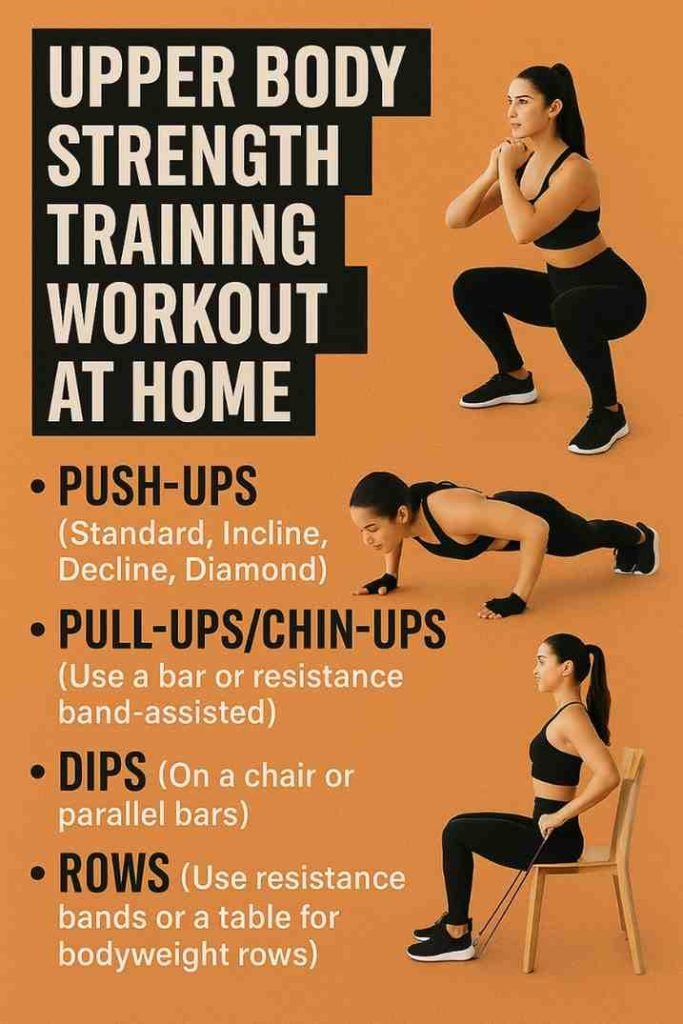
1. Push-Ups (Targets: Chest, Shoulders, Triceps, Core)
- Standard Push-Up: Builds foundational strength.
- Incline Push-Up (Hands on elevated surface): Easier variation for beginners.
- Decline Push-Up (Feet elevated): Increases upper chest & shoulder engagement.
- Diamond Push-Up (Hands close together): Focuses on triceps.
Form Tip: Keep core tight, elbows at a 45-degree angle, and lower chest to the floor.
2. Pull-Ups/Chin-Ups (Targets: Back, Biceps, Shoulders)
- Pull-Up (Overhand grip): Emphasizes lats and upper back.
- Chin-Up (Underhand grip): Engages biceps more.
- Band-Assisted Pull-Up: Helps if you’re still building strength.
Form Tip: Hang fully, pull chest to the bar, and control the descent.
(No bar? Try inverted rows or resistance band pull-aparts instead.)
3. Dips (Targets: Triceps, Chest, Shoulders)
- Chair/Bench Dips: Great for triceps strength.
- Parallel Bar Dips (If available): More advanced, targets chest and shoulders.
Form Tip: Keep shoulders down, elbows slightly back, and lower until arms are at 90 degrees.
4. Rows (Targets: Upper/Mid Back, Biceps, Rear Delts)
- Bodyweight Table Rows: Use a sturdy table or broomstick between chairs.
- Resistance Band Rows: Mimics cable rows for back engagement.
Form Tip: Squeeze shoulder blades together at the top, keep core braced.
Sample Upper Body Routine (3 Rounds)
- Push-Ups x 10-15
- Pull-Ups (or Rows) x 6-10
- Dips x 8-12
- Plank Hold (30-60 sec) for core stability
Progression Tip: Increase reps, slow down tempo, or add resistance (bands/weighted backpack).
Next Up: Core exercises to tie your full-body strength training workout together!
Core & Stability Strength Training Workout at Home
A strong core is the foundation of every movement, enhancing balance, power, and injury prevention. These bodyweight exercises will tighten your midsection and improve functional strength without equipment.
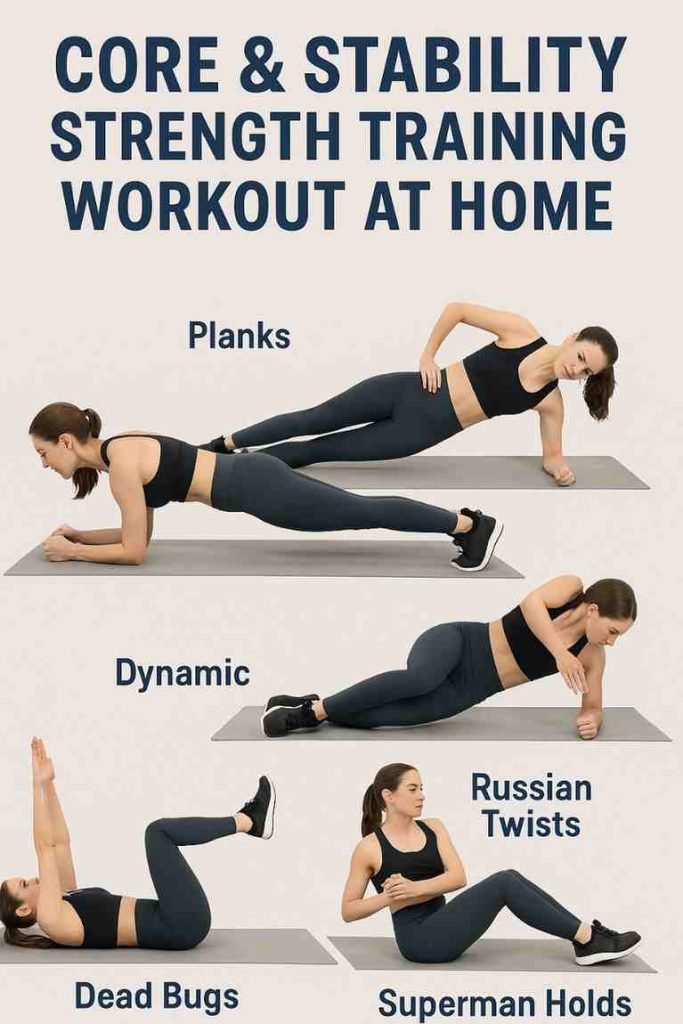
1. Planks (Targets: Entire Core, Shoulders, Glutes)
- Front Plank: Builds endurance in the abs and lower back.
- Side Plank: Oblique-focused, improves lateral stability.
- Dynamic Plank (Shoulder Taps, Knee-to-Elbow): Adds a mobility challenge.
Form Tip: Keep your body in a straight line, engage your glutes, and avoid sagging hips.
2. Dead Bugs (Targets: Deep Core, Hip Flexors, Coordination)
- Basic Dead Bug: Trains anti-extension for spine protection.
- Weighted Dead Bug (Hold Dumbbell/Water Bottle): Increases intensity.
Form Tip: Press lower back into the floor, move limbs slowly with control.
3. Russian Twists (Targets: Obliques, Rotational Strength)
- Bodyweight Version: Great for beginners.
- Weighted (Hold Dumbbell/Resistance Band): Boosts difficulty.
Form Tip: Lean back slightly, twist from ribs (not just arms), keep feet lifted for the advanced version.
4. Superman Hold (Targets: Lower Back, Glutes, Posture)
- Static Hold: Strengthens the posterior chain.
- Pulse Variation: Adds endurance challenge.
Form Tip: Lift chest and thighs off the ground, squeeze glutes, and avoid neck strain.
Sample Core Routine (2-3 Rounds)
- Front Plank – 30-60 sec
- Dead Bugs – 10/side
- Russian Twists – 15/side
- Superman Hold – 30 sec
Progression Tip: Increase hold times, add weights, or try advanced variations like plank-to-push-up combos.
Now you have a complete full-body strength blueprint! Combine lower, upper, and core workouts for balanced results.
Next Steps: How to structure your weekly training split for optimal gains!
Sample Full-Body Workout Routine
Here’s a sample full-body workout routine incorporating the Workout A (Bodyweight Focus) and Workout B (With Equipment) you’ve outlined. This structure is designed to be performed 3-4 days a week, allowing for adequate rest and recovery.
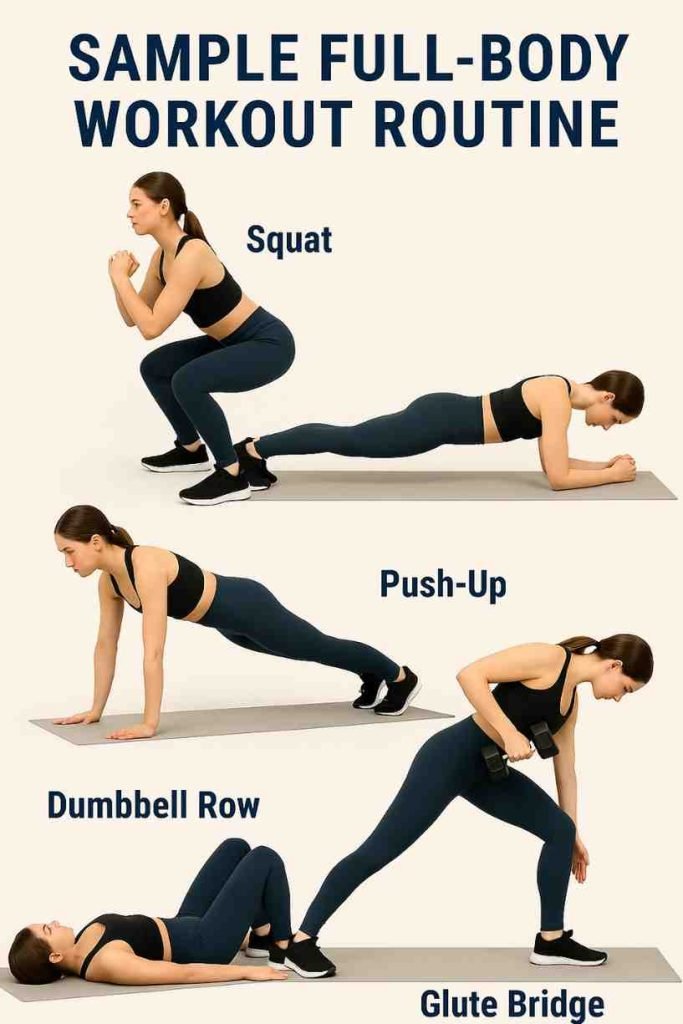
Benefits of a Full-Body Routine:
Full-body workouts are efficient, hitting all major muscle groups in a single session. They are great for building overall strength, improving body composition, and are flexible for busy schedules.
Weekly Structure (3-4 Days/Week):
- 3 Days a Week: Alternate workouts with a rest day in between.
- Week 1: Workout A, Rest, Workout B, Rest, Workout A, Rest, Rest
- Week 2: Workout B, Rest, Workout A, Rest, Workout B, Rest, Rest
- 4 Days a Week:
- Option 1: Workout A, Workout B, Rest, Workout A, Workout B, Rest, Rest
- Option 2 (More recovery): Workout A, Rest, Workout B, Rest, Workout A, Rest, Workout B (This would cycle over more than 7 days for A,B,A,B completion or you can do A, B, A, B in one week with 3 rest days strategically placed).
Important Reminders:
- Warm-Up (5-10 minutes): Always start with dynamic movements like arm circles, leg swings, torso twists, and light cardio (jogging in place, jumping jacks) to prepare your body.
- Cool-Down (5-10 minutes): Finish with static stretches for all major muscle groups worked, holding each stretch for 20-30 seconds.
- Proper Form: Focus on correct technique for each exercise to maximize effectiveness and prevent injury. If unsure, refer to previous detailed descriptions or look up reliable video tutorials.
- Listen to Your Body: Adjust as needed. If something causes pain, stop.
Workout A (Bodyweight Focus)
This workout uses your own bodyweight for resistance, making it accessible anywhere.
Squats:
- Sets & Reps: 3 sets of 12 repetitions
- How: Feet shoulder-width apart, chest up, lower hips back and down as if sitting in a chair. Keep knees behind toes. Push through heels to return. (Refer to the previous detailed description if needed).
- Muscles: Quads, glutes, hamstrings, core.
Push-Ups:
- Sets & Reps: 3 sets of 10 repetitions (or as many as possible with good form – AMRAP Modify to incline push-ups if needed.
- How: Hands slightly wider than shoulders, body straight from head to heels. Lower the chest towards the floor by bending the elbows. Push back up. (Refer to the previous detailed description.)
- Muscles: Chest, shoulders, triceps, core.
Reverse Lunges:
- Sets & Reps: 3 sets of 10 repetitions per leg
- How: Step one leg backward, lowering hips until both knees are at about 90 degrees. Front knee over ankle. Push through the front heel to return to the start. Alternate legs. (Refer to the previous detailed description.)
- Muscles: Quads, glutes, hamstrings.
Plank:
- Sets & Reps: 3 sets, hold for 30 seconds
- How: Hold a push-up top position, or rest on your forearms instead of hands. Elbows should be directly beneath your shoulders. Keep your body in a straight line from head to heels – don’t let your hips sag or lift too high. Engage your core and glutes.
- Muscles: Core (abdominals, obliques, lower back), shoulders, glutes.
- Benefits: Builds core strength and stability, improves posture.
Glute Bridges:
- Sets & Reps: 3 sets of 15 repetitions
- How: Lie on your back, knees bent, feet flat on the floor near your glutes. Squeeze your glutes to lift your hips until your body forms a straight line from shoulders to knees. Lower slowly. (Refer to the previous detailed description.)
- Muscles: Glutes, hamstrings, core.
- Rest: 60-90 seconds between sets.
Workout B (With Equipment)
This workout incorporates dumbbells and a pull-up bar for added resistance and exercise variety.
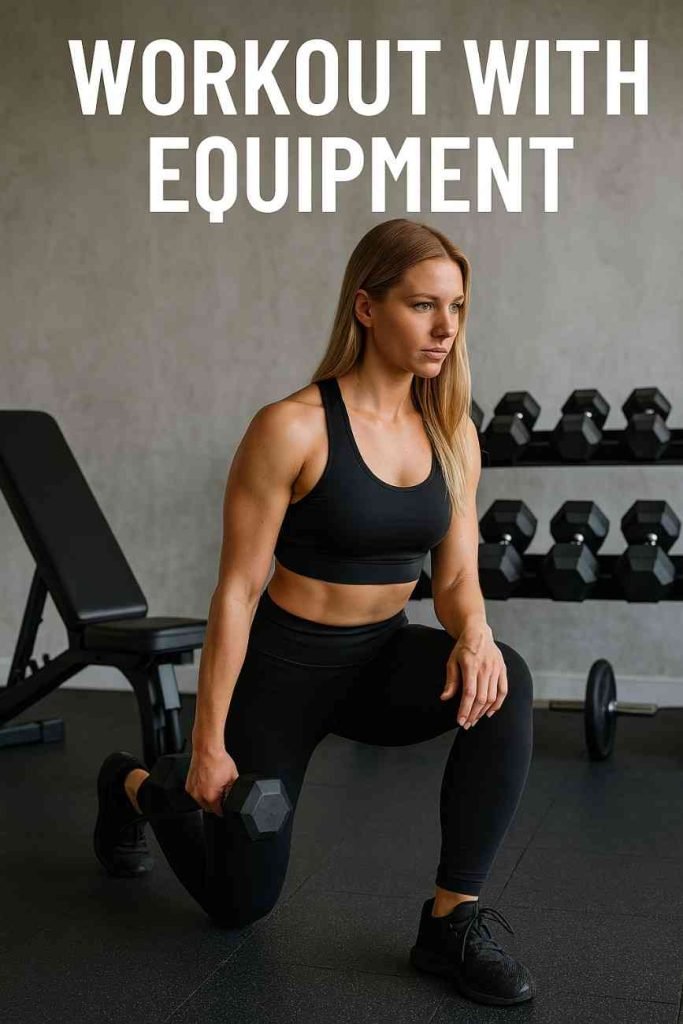
1. Dumbbell Romanian Deadlifts (RDLs)
- Sets & Reps: 3 sets of 10 repetitions
- How:
- Stand with feet hip-width apart, holding dumbbells in front of your thighs with an overhand grip, palms facing your body. Keep a slight bend in your knees throughout the movement (but don’t squat).
- Hinge at your hips, pushing your glutes backward while keeping your back straight (neutral spine). Lower the dumbbells towards the floor, keeping them close to your legs. Lower as far as your hamstring flexibility allows without rounding your back (usually to mid-shin level).
- Engage your glutes and hamstrings to pull yourself back to the upright starting position, squeezing your glutes at the top.
- Muscles worked: Hamstrings, glutes, lower back (erector spinae), core.
- Benefits: Excellent for posterior chain development, improves hip hinge mechanics, and strengthens hamstrings and glutes.
2. Pull-Ups (or Band-Assisted/Alternative)
- Sets & Reps: 3 sets of 8 repetitions (or AMRAP if less than 8. Use resistance band assistance, negative pull-ups, or bodyweight rows if you cannot do 8 unassisted pull-ups.
- How: Grip bar with palms facing away (pull-up) or towards you (chin-up). Start from a full hang. Pull your chest towards the bar. Lower with control. (Refer to the previous detailed description.)
- Muscles: Lats, biceps, traps, rhomboids, core.
3. Dumbbell Shoulder Press:
- Sets & Reps: 3 sets of 10 repetitions
- How:
- Sit on a bench with back support or stand with feet shoulder-width apart, core engaged. Hold a dumbbell in each hand at shoulder height, palms facing forward or neutral.
- Press the dumbbells overhead until your arms are almost fully extended (but not locked out). Keep a slight bend in the elbows at the top.
- Slowly lower the dumbbells back to shoulder height.
- Muscles worked: Deltoids (shoulders – primarily anterior and medial heads), triceps, upper chest.
- Benefits: Builds shoulder strength and size, improves overhead pressing capability.
4. Dead Bugs:
- Sets & Reps: 3 sets of 12 repetitions per side (24 total)
- How:
- Lie on your back with your arms extended towards the ceiling and your knees bent at 90 degrees, so your shins are parallel to the floor (tabletop position for legs).
- Engage your core, pressing your lower back gently into the floor. Maintain this contact throughout the exercise.
- Slowly extend your right arm backwards towards the floor (overhead) while simultaneously extending your left leg forwards towards the floor. Lower them as far as you can while keeping your lower back pressed into the floor and your core engaged.
- Return your right arm and left leg to the starting position with control.
- Repeat with your left arm and right leg. This is one repetition per side.
- Muscles worked: Deep core muscles (transverse abdominis), rectus abdominis, obliques, hip flexors.
- Benefits: Excellent for core stabilization, improving coordination, and strengthening the core without stressing the spine.
Rest: 60-90 seconds between sets.
Progression:
- Increase Reps/Sets: Once you can comfortably complete the target reps and sets with good form, try adding a few more reps or an additional set.
- Increase Weight (for Workout B): Gradually increase the weight of the dumbbells.
- Decrease Rest Times: Slightly shorten your rest periods between sets.
- More Challenging Variations: Move to harder versions of exercises (e.g., from incline push-ups to standard push-ups, or from band-assisted pull-ups to unassisted).
- Improve Form and Control: Focus on the quality of each repetition, including the eccentric (lowering) phase of movements.
Consistency is key! Stick with your routine, listen to your body, and enjoy the process of getting stronger and healthier.
Progression Tips for Your Strength Training Workout
To keep seeing results from your home workouts, you need to continuously challenge your muscles. Here are the most effective ways to progress:
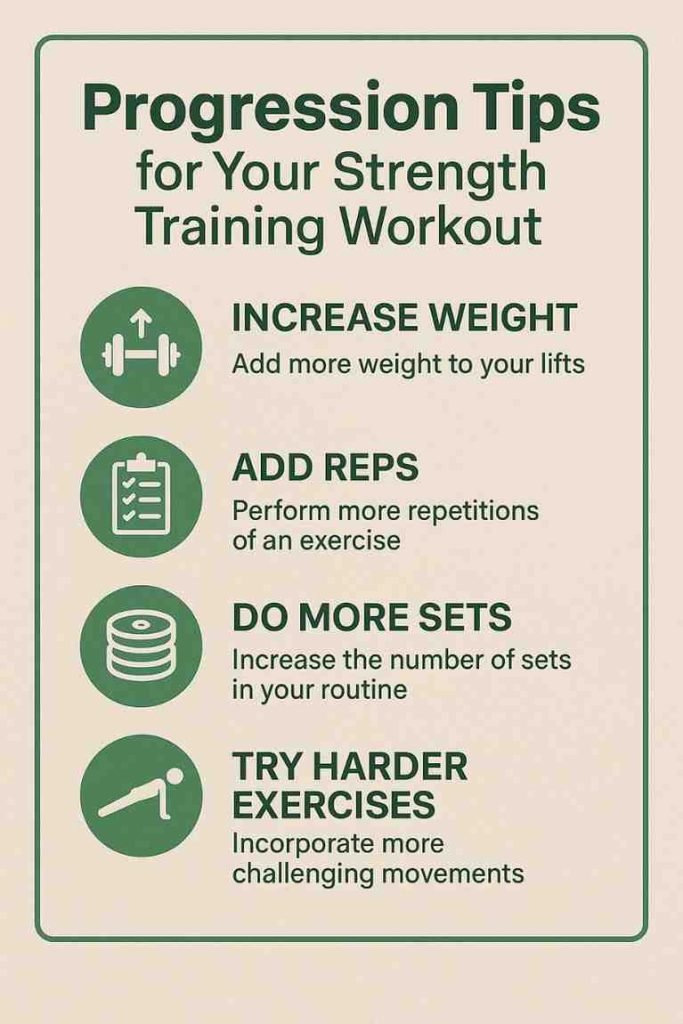
1. Increase Volume (Reps & Sets)
- Start with 3 sets of 8-12 reps per exercise.
- Gradually add 1-2 reps each week until you hit the top of your rep range.
- Then increase sets (e.g., 3 sets → 4 sets) or move to a harder variation.
2. Add Resistance
- Bodyweight → Weighted: Use dumbbells, kettlebells, or household items (water jugs, backpacks).
- Resistance Bands: Great for adding tension to push-ups, rows, and squats.
- Vest/Ankle Weights: Increases difficulty for bodyweight movements.
3. Slow Down Tempo (Time Under Tension)
- Try 4-second lowers (e.g., slow squats, push-ups).
- Pause at the hardest point (e.g., bottom of a lunge).
- Increases muscle engagement without extra weight.
4. Try Advanced Variations
- Lower Body: Pistol squats, Bulgarian split squats, single-leg deadlifts.
- Upper Body: One-arm push-ups, archer push-ups, weighted pull-ups.
- Core: Dragon flags, hanging leg raises, weighted Russian twists.
5. Reduce Rest Time
- Start with 60 seconds rest between sets.
- Progress to 30 sec for endurance/metabolic stress.
Sample Progression Plan (4-Week Example)
| Week | Squats | Push-Ups |
|---|---|---|
| 1 | 3×12 bodyweight | 3×10 standard |
| 2 | 3×15 bodyweight | 3×12 standard |
| 3 | 3×10 goblet (10kg) | 3×8 diamond |
| 4 | 4×10 goblet (12kg) | 3×10 weighted* |
(Use a backpack with books for weighted push-ups.)*
Key Rule: Progress one variable at a time (weight, reps, or difficulty) to avoid overtraining.
Stuck? Deload every 4-6 weeks (lighter workouts) to recover and prevent plateaus.
Next: How to track your progress for long-term success!
Recovery & Nutrition Tips for Optimal Strength Gains
Achieving optimal strength gains isn’t just about the hard work you put in during your workouts; it’s equally about how you recover and fuel your body. Smart recovery and nutrition strategies are crucial for muscle repair, growth, and consistent progress. Here are some key tips:
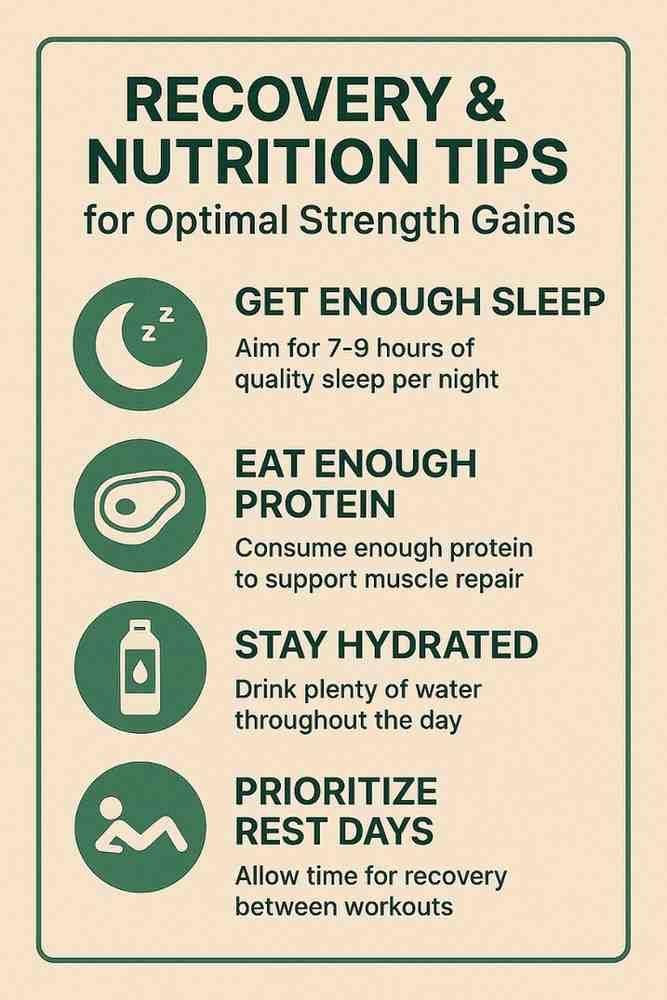
I. Recovery Tips for Optimal Strength Gains:
Your muscles grow and strengthen during periods of rest and repair, not during the workout itself. Prioritizing recovery can significantly enhance your results.
1. Prioritize Quality Sleep:
- Why: During deep sleep, your body releases Growth Hormone (GH), which is vital for muscle repair and growth. Sleep deprivation can hinder protein synthesis (the process of building muscle) and lead to decreased performance.
- How much: Aim for 7-9 hours of quality, uninterrupted sleep per night. Individual needs may vary, especially during intense training periods.
- Tips: Maintain a consistent sleep schedule, create a dark and cool sleep environment, and limit screen time before bed.
2. Strategic Rest Days:
- Why: Your muscles need time to recover from the stress of strength training. Overtraining can lead to injury, fatigue, and plateaus.
- How: Incorporate rest days into your weekly training split. Don’t train the same muscle groups intensely on consecutive days. Listen to your body; if you’re feeling overly fatigued or sore, an extra rest day might be beneficial.
3. Active Recovery:
- Why: Light physical activity on rest days or after intense workouts can promote blood flow to the muscles. This helps deliver nutrients and remove waste products, potentially reducing muscle soreness (DOMS) and speeding up recovery.
- What: Opt for low-intensity activities like walking, light cycling, swimming, yoga, or dynamic stretching. Avoid anything that causes further muscle fatigue.
4. Hydration is Key:
- Why: Water is essential for numerous bodily functions, including nutrient transport to muscle cells, waste removal, and temperature regulation. Dehydration can impair performance, slow recovery, and increase the risk of muscle cramps.
- How much: Drink water consistently throughout the day, not just during workouts. A general guideline is to drink half your body weight (in pounds) in ounces of water. Increase intake during and after intense exercise, especially in hot or humid conditions.
- Tip: Monitor your urine color; pale yellow indicates good hydration.
5. Cool-Down and Stretching:
Why: A proper cool-down helps gradually bring your heart rate back to normal. Stretching, particularly static stretching (holding a stretch for 15-30 seconds) post-workout, can help improve flexibility, reduce muscle tension, and potentially alleviate soreness.
How: Spend 5-10 minutes after your workout on light cardio (like walking) followed by stretching the major muscle groups you worked.
6. Myofascial Release (Foam Rolling):
Why: Techniques like foam rolling can help relieve muscle tightness, improve blood flow, and reduce soreness by working on the fascia (connective tissue surrounding muscles).
When: Can be done post-workout or on recovery days.
7. Manage Stress:
Why: Chronic stress elevates cortisol levels, a hormone that can break down muscle tissue and hinder recovery.
How: Incorporate stress-reducing activities into your routine, such as meditation, deep breathing exercises, spending time in nature, or engaging in hobbies.
II. Nutrition Tips for Optimal Strength Gains:
Nutrition provides the building blocks and energy your body needs to repair damaged muscle fibers and build new, stronger tissue.
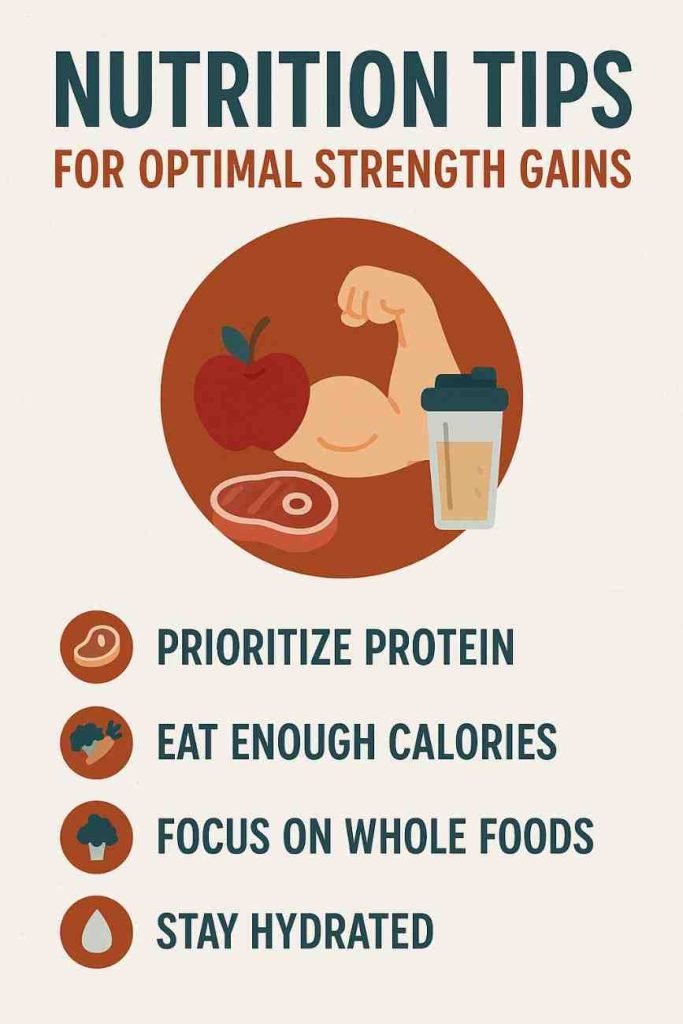
1. Sufficient Protein Intake:
- Why: Protein is the primary macronutrient responsible for muscle repair and growth (muscle protein synthesis).
- How much: For active individuals looking to build muscle, aim for approximately 1.6 to 2.2 grams of protein per kilogram of body weight per day (or about 0.73 to 1 gram per pound).
- Sources: Lean meats (chicken, turkey, beef), fish, eggs, dairy products (Greek yogurt, cottage cheese, milk), whey or casein protein powders, and plant-based sources like tofu, tempeh, lentils, beans, and quinoa.
- Timing: Distribute your protein intake throughout the day, including some with each meal and snack. Consuming protein within a couple of hours post-workout can be beneficial.
2. Adequate Carbohydrate Consumption:
- Why: Carbohydrates are your body’s primary energy source, fueling your workouts and replenishing muscle glycogen stores depleted during exercise. Glycogen is crucial for performance and recovery.
- How much: The amount varies based on activity level and individual needs, but generally, 45-65% of your total daily calories should come from carbohydrates. Strength athletes might aim for 3-7 grams of carbohydrates per kilogram of body weight, depending on training volume and intensity.
- Sources: Focus on complex carbohydrates like whole grains (oats, brown rice, quinoa), fruits, vegetables, and legumes. Simple carbs can be useful around workouts for quick energy.
- Timing: Consuming carbohydrates pre-workout can provide energy, while post-workout carbs help replenish glycogen and support recovery (often in a 3:1 or 4:1 carb-to-protein ratio post-exercise).
3. Don’t Fear Healthy Fats:
- Why: Dietary fats are essential for hormone production (including testosterone, which plays a role in muscle growth), vitamin absorption (fat-soluble vitamins A, D, E, K), and overall health.
- How much: Aim for 20-35% of your total daily calories from fats.
- Sources: Prioritize unsaturated fats found in avocados, nuts, seeds (chia, flax), olive oil, and fatty fish (salmon, mackerel), which are rich in omega-3 fatty acids known for their anti-inflammatory properties.
- Note: While fats are important, they digest slower, so you might want to limit high-fat meals immediately before intense workouts.
4. Caloric Intake – Fueling Growth:
- Why: To build muscle, you generally need to be in a slight caloric surplus, meaning you consume slightly more calories than you burn. This provides the extra energy needed for tissue repair and growth.
- How much: A modest surplus of 250-500 calories above your maintenance level is often recommended to promote lean muscle gain while minimizing fat gain. Adjust based on your progress and goals.
5. Nutrient Timing (Peri-Workout Nutrition):
- Pre-Workout: Consume a balanced meal or snack containing carbohydrates and some protein 1-3 hours before training to provide energy and prime your muscles.
- Intra-Workout (for long/intense sessions): Easily digestible carbohydrates (e.g., sports drinks, gels) can help maintain energy.
- Post-Workout: The “anabolic window” (often considered 30-60 minutes, though the window is likely larger) is a good time to consume protein and carbohydrates to kickstart recovery, replenish glycogen, and stimulate muscle protein synthesis.
6. Micronutrients Matter:
- Why: Vitamins and minerals play crucial roles in energy metabolism, muscle function, oxygen transport, and recovery.
- Key Micronutrients:
- Vitamin D: Supports muscle function and protein synthesis.
- Calcium: Important for muscle contraction and bone health.
- Iron: Essential for oxygen transport to muscles.
- Magnesium: Involved in muscle relaxation, energy production, and can help prevent cramps.
- Zinc: Plays a role in hormone production and tissue repair.
- B Vitamins: Crucial for energy metabolism.
- Vitamin C & E (Antioxidants): Help combat exercise-induced oxidative stress.
How: Eat a varied diet rich in fruits, vegetables, whole grains, and lean proteins to ensure adequate micronutrient intake.
7. Consider Supplements Wisely (Optional):
- Note: Supplements should supplement a good diet, not replace it.
- Potentially Beneficial:
- Creatine Monohydrate: Well-researched for improving strength, power, and muscle mass.
- Whey/Casein Protein: Convenient sources to help meet protein targets.
- Omega-3 Fish Oil: If dietary intake is low, it can help with inflammation.
- Vitamin D: If deficient (common in many populations).
- Action: Always research and consult with a healthcare professional or registered dietitian before starting new supplements.
By consistently applying these recovery and nutrition principles, you’ll create an optimal environment for your body to adapt to your strength training, leading to better performance, faster recovery, and ultimately, greater strength gains.
Frequently Asked Questions (FAQ)
1. Can I build muscle with just bodyweight exercises?
Yes! Bodyweight exercises like push-ups, pull-ups, and pistol squats can effectively build muscle, especially for beginners. To keep progressing:
- Increase reps/sets
- Slow down tempo
- Use advanced variations (e.g., one-arm push-ups)
- Add resistance (weighted vest, bands)
2. How often should I do strength training workouts?
- Beginners: 3x/week (full-body sessions)
- Intermediate/Advanced: 3–4x/week (can split upper/lower)
- Rest: At least 48 hours between working the same muscle group
3. Do I need to do cardio with strength training?
Not necessarily, but it helps for:
- Heart health
- Fat loss (if that’s a goal)
- Recovery (light cardio on rest days)
Best options: Walking, cycling, or HIIT 1–2x/week.
4. What if I don’t have weights?
Use household items:
- Water jugs/detergent bottles for curls or presses
- Backpack filled with books for weighted squats
- Towels for sliding hamstring curls
5. How long until I see results?
- Strength gains: 4–6 weeks
- Muscle growth: 8–12 weeks (with progressive overload)
- Fat loss: Depends on diet, but workouts help preserve muscle
6. Should I train to failure?
Not every set. Leave 1–2 reps “in reserve” to avoid burnout and injury.
7. What’s the best time to workout?
Whenever you’re consistent! Morning workouts may boost energy, while evening sessions can leverage peak strength.
8. Can I do strength training if I’m sore?
- Mild soreness: Yes, light movement helps recovery.
- Severe soreness: Rest or train a different muscle group.
9. How do I know if my form is correct?
- Film yourself and compare to tutorials
- Start with lighter weights to perfect technique
- If something hurts (not burns), stop and adjust
10. What’s the #1 mistake beginners make?
Skipping progressive overload. If you don’t gradually increase difficulty (weight, reps, or difficulty), progress stalls.
Your Journey to a Stronger You Starts Now!
This guide has walked you through everything you need to know to embark on an effective and rewarding full-body Strength Training Workout journey right from the comfort of your home. We’ve explored the significant benefits, from building lean muscle and shedding fat to improving your mobility and enjoying unparalleled convenience. We’ve also debunked common myths, proving that you don’t need a fancy gym membership or complicated equipment to achieve incredible results.
You’re now equipped with a solid understanding of:
- The compelling benefits of at-home full-body strength training.
- Essential and optional equipment, including budget-friendly DIY alternatives, allowing you to start with what you have.
- A diverse range of exercises targeting your lower body, upper body, and core, complete with variations to suit your fitness level.
- Sample workout routines like Workout A (Bodyweight Focus) and Workout B (With Equipment) to provide a structured path forward.
- Crucial recovery and nutrition tips to optimize your strength gains, repair muscle, and keep you feeling your best.
The path to a stronger, healthier, and more resilient you is not about perfection, but about consistency and progress. Start where you are, use what you have, and do what you can. Listen to your body, celebrate small victories, and be patient with the process.
Embrace the power of a Strength Training Workout at home, and unlock your potential to transform not just your physique but your overall well-being. The most important step is the one you take today. Get started, stay consistent, and enjoy the incredible journey ahead!
